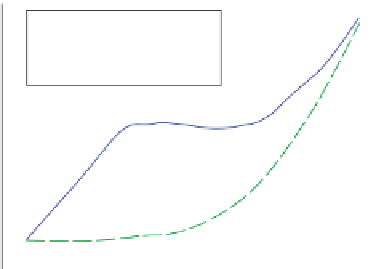Biomedical Engineering Reference
In-Depth Information
Muscle length-tension relationship
Passive force
Active force
Total force
Muscle length
FIGURE 6.4
Schematic of the muscle length-tension relationship, demonstrating the active, passive
and net tension produced as a function of muscle length.
force-length relationship (
Gordon et al., 1966
). In addition to this active force,
muscle and tendon exhibit passive elastic properties, such that stretching a muscle
eventually produces passive force, like a spring. If you combine these active and
passive forces, the net force from a muscle typically increases with muscle length,
but with a curvilinear plateau in the region of optimal muscle length (
Figure 6.4
).
The torque produced about a joint is the product of the muscle force and its
moment arm with respect to the joint center of rotation. Thus, torque is a function
of both muscle force-producing capability and the mechanical advantage afforded
by the muscle-tendon complex. As joint angles change throughout the range of
motion, this mechanical advantage changes. These changes can be specific to
each joint, thus no one relationship can be modeled for all joints (
Frey-Law et al.,
2012b
). Thus, the torque-angle relationship does not always appear to be consis-
tent with the force-length relationship.
Population-specific factors that influence strength include: male versus female;
young-versus old-adult; and active/trained versus sedentary cohorts, to name a
few. Typically men exhibit approximately 50% greater peak torque than females
but this too can vary across joint regions (
Frey-Law et al., 2012b
). As mentioned
above, these sex differences result primarily from cross-sectional area as opposed
to the inherent muscle properties for men and women (e.g., specific tension of
muscle). Certainly this does not discount systemic physiological differences
between men and women, including sex differences in the hormonal milieu, from
playing a strong role in muscle strength. It does, however, suggest the contractile
proteins are not in and of themselves the source of these differences per se, but
rather the number of these muscle fibers in parallel. Accordingly, digital humans
(DHs) need to be specific to male versus female avatars not only in physical
anthropometry (e.g., height and weight) but also in strength properties.








Search WWH ::

Custom Search